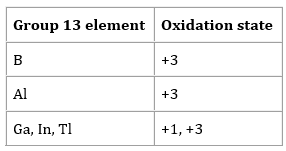Group 13 elements – oxidation states
- The atoms of these elements have three electrons in their outermost shell or we can say three valance electrons, two in the s-subshell and one in the p-subshell. Therefore, all these elements can show a maximum of +3 oxidation state.
- It may also be noted that due to the small size of a boron sum of its first three ionization enthalpy is very high. Hence, it cannot form +3 ions and can only form covalent compounds.
- But as we move from B to Al, the sum of the first three ionization enthalpies of Al considerably decreases and is therefore, can form ions. In fact, aluminium is highly electropositive metal. However, as we move down the group, due to the poor shielding effect of d- and f- electrons, the increased nuclear charge holds ns electron tightly and allowing only p-electrons to take part in bonding.
- As a result, as we move down the group the elements show +1 and +3 oxidation states. Boron shows only +3 oxidation state in its compounds. Except for boron, all the elements also show a +1 oxidation state.
- As we move down the group +1 oxidation state becomes more stable and thallium shows only +1 oxidation state.
- In fact, in Ga, In and, Tl both +3 and +1 oxidation states are observed. However, in Ga and In +3 oxidation state is more stable and hence both salts disproportionate in the water which means they undergo self oxidation and reduction as shown below:
- In the case of the last element of the group, thallium, +1 oxidation state has been found to be more stable than +3 oxidation state.
- This variation in oxidation states can be explained on the basis of the inert pair effect.
- The elements of group 13 have three electrons in their valance shell and therefore, they exhibit +3 oxidation state.
- However, it has been observed that in addition to +3 oxidation state they also show +1 oxidation state. The +1 oxidation state becomes more stable as we move down the group from B to Tl. For example, the +1 oxidation state of Tl is more stable than the +3 oxidation state. Thus, thallous compounds such as TlOH and TlCl are more stable than their respective thallic compounds.
- This is due to the fact that in the case of the last element, after removal of one electron from the p-orbital, the remaining s-orbital electrons behave like stable noble gas and do not take part in the compound formation. This reluctance of the s-electron pair to take part in the chemical combination is called inert pair effect.
- As a result of the inert pair effect, the heavier elements of p-block show oxidation states two- unit less than the group oxidation state. This helps to explain the stability of lower oxidation state for the heavier elements of a group.
- The decreasing stability of +3 oxidation state with increasing atomic number arises because of the decrease in bond energy with size from Al To Tl. As a result, the energy required to un-pair the electrons is not compensated by the energy released in forming the two additional bonds.
